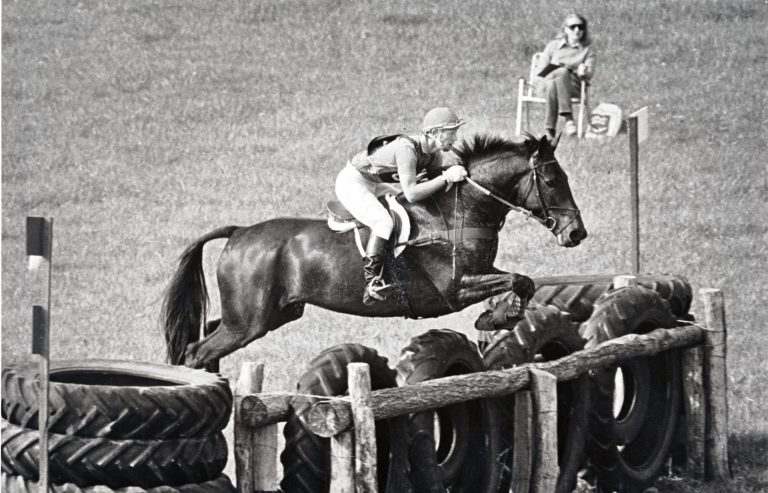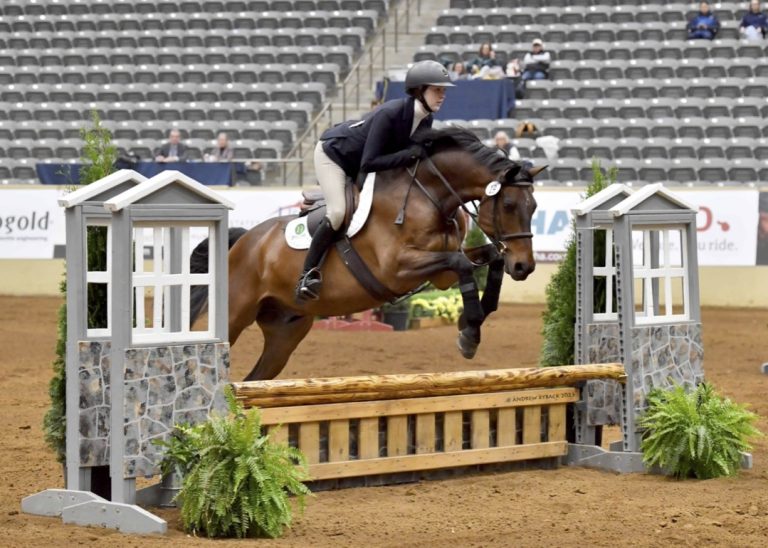When jumping, do you
• turn your foot out too much?
• lose foot contact with the stirrup?
• have difficulty keeping your thigh on?
• roll to the outside of your foot?
This exercise will teach you that a heel eversion is all that is necessary to correct these issues. A slight eversion of the heel places the rider’s weight to the inside edge on the stirrup without turning the foot out.
Slightly weighting the inside edge of your foot secures your leg, keeps your leg close to the horse and widens the area at the back of your hip while allowing your heel to sink down.
 1
1 2
2 3
3 4
4Exercise: On The Ground
Sit on a flat surface with both feet on the ground. Make sure one foot is flat on the floor. This is the foot you will start with. Your heel will be in a neutral position when the weight is evenly distributed across the foot from side to side and front to back. Think of a line dropping from the back of your knee down through the center of your heel.
Photo 1: Evert your foot by pressing the inside edge of your heel against the floor while allowing the outside edge to lift slightly. Try not to let your heel slide. It will now be slightly to the outside of the body’s midline. Feel how your thigh moves medially (toward the midline) from knee to hip. Notice how this widens the area at the back of your hip. This would keep your thigh against the saddle without having to use a lot of grip because your whole leg has moved inward. Repeat with your other foot and then with both feet at the same time.
Photo 2:Invert your foot by pressing the outside edge of your heel toward the floor, slightly lifting the inside edge while keeping the heel in place. Your heel is slightly to the inside of the neutral starting position. Observe that your knee turns outward and the area at the back of the hips closes. If you invert both feet together, your knees will widen.
Photo 3:Supinate your foot by lifting your heel and the inside edge of your foot off the floor. Only the outside edge of your pinky toe remains. Feel how your knee turns out. When you supinate on your horse, most of your weight is on your seat and the horse’s back because your leg has come away from the saddle. You will have to grip with the back of your leg and calf or override this with a lot of inner-thigh grip.
Photo 4:Pronate by lifting the outside edge of your foot off the floor, leaving the inside edge of your heel on the floor. Your knee will internally rotate and adduct. When you pronate with both feet, the knees may touch. In the saddle, this causes you to pinch with your knees and restrict your pelvis. In this position, the lower back hollows and you have to brace the foot against the stirrup, pushing the lower leg forward to get your heels down. The hips close, causing you to lie on your horse’s neck over fences.
When pronated and supinated, your knees are no longer aligned over your feet. This stresses your knees when riding and walking. Ideally, your knee is aligned over your second toe both on the flat and over fences.
Adapted from 40 5-Minute Jumping Fixes by Wendy Murdoch. Available at www.EquineNetworkStore.com.
This article originally appeared in the August 2015 issue of Practical Horseman.










